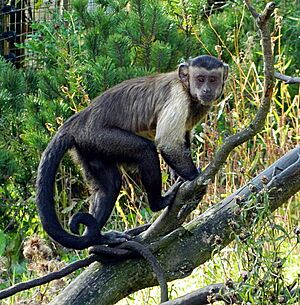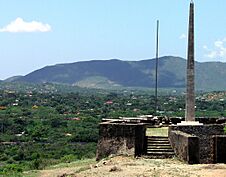Margarita Island capuchin facts for kids
Quick facts for kids Sapajus apella margaritae |
|
|---|---|
 |
|
| Conservation status | |
| Scientific classification |
|
| Kingdom: | Animalia |
| Phylum: | Chordata |
| Class: | Mammalia |
| Order: | Primates |
| Suborder: | Haplorhini |
| Infraorder: | Simiiformes |
| Family: | Cebidae |
| Genus: | Sapajus |
| Species: | |
| Subspecies: |
S. a. margaritae
|
| Trinomial name | |
| Sapajus apella margaritae (Hollister, 1914)
|
|
| Synonyms | |
|
Cebus apella margaritae Hollister, 1914 |
|
The Margarita Island capuchin (Sapajus apella margaritae) is a special type of monkey. It's also called the tufted Margarita Island capuchin. These monkeys live only on Margarita Island in Venezuela, which is in the Caribbean Sea.
These capuchins are medium-sized monkeys. They have black arms, legs, tails, and heads. Their bellies and backs are brown. They are primates, which means they are part of the same group as humans and other monkeys. They usually travel in groups of 2 to 18 monkeys.
Margarita Island capuchins mostly eat fruit. But they also enjoy leaves from bromeliad plants, insects, cactus, and small animals. They are the main type of monkey on Margarita Island. They help spread seeds around the island, which is important for the plants.
Sadly, the Margarita Island capuchin is an endangered species. This means their numbers are getting very low. They are on the International Union for Conservation of Nature (IUCN) list. Their population is shrinking because their homes are being broken up, and they are hunted or caught for the pet trade. People are working to protect these monkeys and teach others about their situation.
Contents
What is a Margarita Island Capuchin?
The Margarita Island capuchin is part of the Cebidae family. This family includes many "New World monkeys" like squirrel monkeys, tamarins, and marmosets. It is known as a subspecies of the tufted capuchin. This means it's a specific kind of tufted capuchin.
These capuchins are fairly small. They have beige and black fur. As we mentioned, they mostly eat fruit, but they also enjoy insects, bromeliad leaves, cactus, and small animals. On Margarita Island, these monkeys are at the top of the food chain. They don't have any natural predators there. They live in small groups, usually with 2 to 18 monkeys.
The number of Margarita Island capuchins has been going down for a long time. In 1994, there were only about 200 to 350 of them. This drop in numbers is mainly because their habitat is being broken up. They are also affected by illegal animal trade and hunting. Projects are now working to help save this species.
How We Know About Them
The Margarita Island capuchin was first described in 1914. Back then, it was called Cebus apella margaritae. Later, in the 1700s, scientists studied capuchin monkeys more closely. They found enough differences in their behavior, genes, and how they live to split them into two main groups: the "robust" capuchins (Sapajus) and the "gracile" capuchins (Cebus).
Around the 2000s, more studies showed that these two groups looked so different that they should be considered separate. That's when the Margarita Island capuchin's name was changed to its current scientific name, Sapajus apella margaritae.
Physical Appearance
The Margarita Island capuchin has a black head and neck. It also has "sideburns" of black fur that go from the top of its head down to its throat. Its tail, hands, and legs are also black. The shoulders and upper arms are beige. Their back is light brown with a dark stripe running from their neck to their tail. They also have black hair around their ears that can look like tufts.
Baby and young Margarita Island capuchins look similar to adults. However, their foreheads are a lighter color. Female capuchins are about 38 cm (about 15 inches) long from head to body and weigh about 2.5 kg (about 5.5 pounds). Males are a bit larger, about 41 cm (about 16 inches) long and weighing around 3.7 kg (about 8 pounds). Both males and females have tails that are about 40 cm (about 16 inches) long.
Where They Live
The Margarita Island capuchin lives only on the eastern side of Margarita Island. This island is about 394 square miles (1,020 square kilometers) in size. It's the only place in the world where these monkeys are found!
They live in mountain forests at lower elevations. You can usually find them about 300 to 500 meters (about 980 to 1,640 feet) above sea level. However, they can also be found from 40 to 830 meters (about 130 to 2,720 feet) high. These monkeys tend to stay in trees, usually 5 to 10 meters (about 16 to 33 feet) above the ground. But they also spend a lot of time on the ground.
They also live in protected forests within Margarita Island's national parks. These include Cerro el Copey and the national monument Cerro Matasiete y Guayamuri. The way they are spread out across the island might be because their habitat is broken up into smaller pieces.
Protecting the Margarita Island Capuchin
The Margarita Island capuchin was once the only primate on Margarita Island. They play a very important role in spreading seeds, which helps new plants grow. They are also the main predator on the island.
However, over the years, the number of these monkeys has been going down. Because of this, the Margarita Island Capuchin has been on the IUCN Red List as a critically endangered species since 1996. It's also on Venezuela's own red list. The main reasons for this decline are that their homes are being broken up, they are hunted, and they are caught for illegal pet trade.
In 2005, a group of experts started the "Margarita Island Capuchin Project." Their goal is to study the monkey population, do research, teach people about the species, and work on conservation efforts. Thanks to these efforts, two national parks and three natural monuments on the island have been declared protected areas for these special monkeys.



